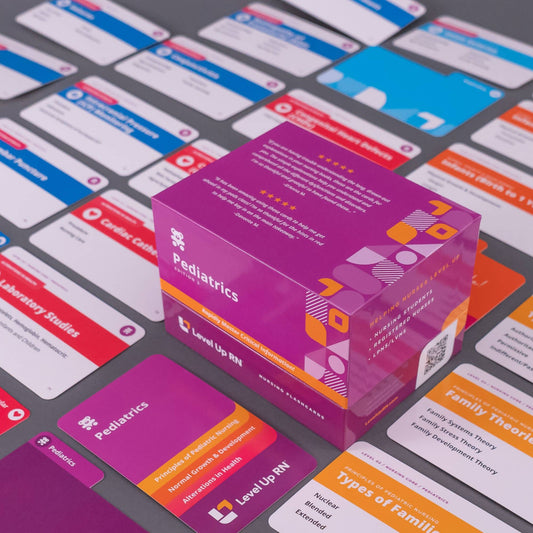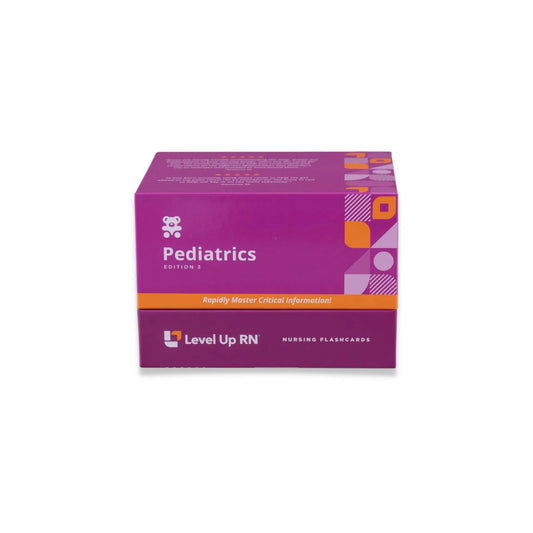Peds, part 30: Nervous Disorders - Pediatric Nervous Diagnostic Tests - EEG, Lumbar Puncture, ICP Monitoring
Updated: Cathy ParkesThe following nervous system diagnostic tests: electroencephalogram (EEG), lumbar puncture, and intracranial pressure (ICP) monitoring.
Full Transcript: Peds, part 30: Nervous Disorders - Pediatric Nervous Diagnostic Tests - EEG, Lumbar Puncture, ICP Monitoring
Full Transcript: Peds, part 30: Nervous Disorders - Pediatric Nervous Diagnostic Tests - EEG, Lumbar Puncture, ICP Monitoring
Hi. I'm Cathy with Level Up RN. In this video, I am going to begin my coverage of pediatric nervous system disorders as well as diagnostic tests. Specifically, in this video, I will be talking about an EEG, a lumbar puncture, as well as ICP monitoring. If you have our Level Up RN pediatric nursing flashcards, definitely pull those out so you can follow along with me. At the end of the video, I will be giving you guys a little quiz to test your knowledge of some of the key points I'll be covering in this video, so definitely stay tuned for that.
First up, we have an EEG or electroencephalogram. This is a diagnostic test where we place electrodes on the patient's scalp and record the electrical activity of the brain. We would use this test to help diagnose seizures as well as sleep disorders. In terms of nursing care, prior to the procedure, you want to advise your patient to wash their hair. This is because the electrodes will not stick well to a greasy scalp. In addition, we want to advise our patient to arrive to the test sleep deprived because this makes it more accurate and easier to diagnose epilepsy. In addition, the patient should avoid stimulants such as caffeine and sedatives before the procedure. And NPO is not required for an EEG because we are not using anesthesia. During the procedure, hyperventilation and/or strobe lights may be used to increase the likelihood of seizure activity, so you may want to give your patient a heads-up about that.
Next up, let's talk about a lumbar puncture, which is a diagnostic test where we get a sample of the patient's cerebral spinal fluid, or CSF, from the spinal canal. We would use this test to help diagnose meningitis, a subarachnoid hemorrhage, as well as other neurological disorders. In terms of nursing care, in order to decrease the pain associated with this procedure, we want to apply Emla cream over the area where we're going to be doing the lumbar puncture and let it sit there for an hour. Right before the procedure, we want to have the child empty their bladder, and then we need to position the child on their side in a fetal position such that their back is arched. Alternatively, we can have them lean over a table like this and, again, keeping their back arched so we can do that lumbar puncture. After the procedure, we're going to need the child to lay flat for several hours, and we're going to monitor for any signs of a CSF leak, which can include a severe headache. If the patient has a CSF leak, they may require an epidural blood patch. This is where a little bit of the patient's blood is injected into that area where we did the lumbar puncture, and that blood will clot and seal off the area where we have that CSF leak.
Next, let's talk about ICP monitoring or intracranial pressure monitoring. This is where a device is inserted in the patient's cranial cavity in the operating room in order to measure pressure. And obviously, this is very invasive and carries a high risk of infection. Indications for ICP monitoring include a Glasgow coma scale score less than eight, which means the patient is in a coma. So let's talk more about increased intracranial pressure. It's going to be important for you to know the early versus the late signs of increased ICP. Early signs in infants can include irritability, a high-pitched cry, poor feeding, a bulging fontanelle, as well as separated cranial sutures. We may also see something called the setting-sun sign, which is where the infant's eyes appear driven downward. In children, early symptoms of increased intracranial pressure include a headache, nausea and vomiting, lethargy, as well as seizures. Late symptoms of increased intracranial pressure include bradycardia, a decrease in level of consciousness, abnormal respirations, such as Cheyne-Stokes respirations, and a coma.
All right. It's quiz time. Are you guys ready? I have three questions for you, although the third question's kind of multipart, but I think you'll like it and find it helpful. First question. Prior to an EEG, the patient needs to be NPO for four to six hours. True or false? The answer is false. So NPO is not required for an EEG because we are not using anesthesia with that test. Question number two. How should the patient be positioned for a lumbar puncture? The answer is on their side in a fetal position or stretched over a table such that their back is arched. All right. Question number three. With this question, I want you to tell me if I give you a symptom, if that is an early or late sign of increased intracranial pressure. Are you guys ready? All right. First symptom is irritability. That's an early symptom. Second is poor feeding. That is also an early symptom. Decreased level of consciousness. That is a late sign. Bradycardia. That is also a late sign. And abnormal respirations. That is a late sign. Okay. I hope you did well in that quiz, and I hope you found this video helpful as well. If you did, make sure to like the video. Leave me a comment. And I will see you soon on another video.


